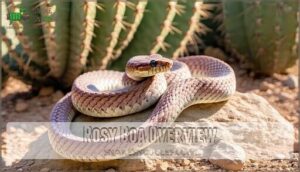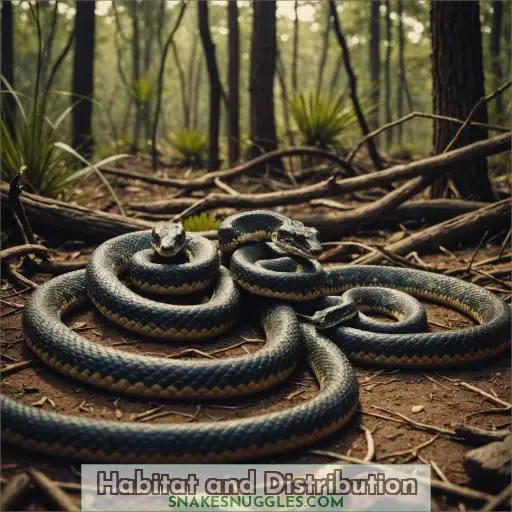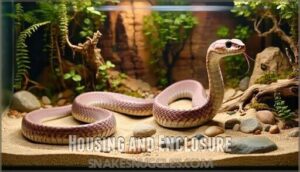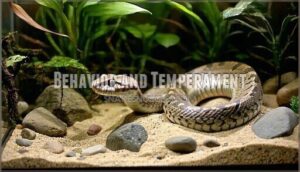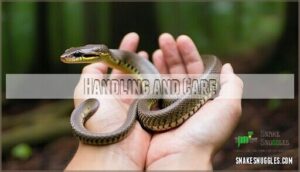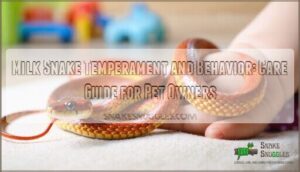This site is supported by our readers. We may earn a commission, at no cost to you, if you purchase through links.
1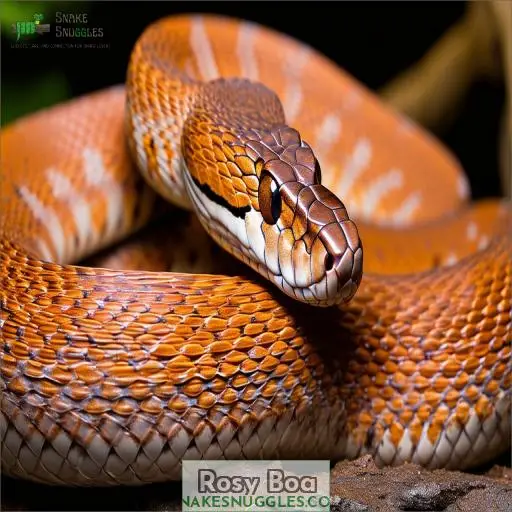 You’re captivated by the rosy boa, aren’t you?
You’re captivated by the rosy boa, aren’t you?
These docile "teddy bear" snakes make excellent pets for reptile enthusiasts.
Hailing from the deserts of southwestern U.S. and Mexico, rosy boas sport alluring red-brown stripes on gray bodies.
While small (typically under 3 feet), they boast hardy constitutions and moderate care needs—ideal for beginners.
With proper housing, heating, and a diet of appropriate prey items, these gentle ambushers thrive in captivity.
Their calm demeanor and minimal space requirements allow easy handling and housekeeping.
But don’t let their charms fool you—to truly appreciate these mesmerizing serpents, you’ll want to explore their fascinating world in depth.
Table Of Contents
- Key Takeaways
- Rosy Boa Overview
- Physical Characteristics
- Habitat and Distribution
- Housing and Enclosure
- Behavior and Temperament
- Feeding and Diet
- Handling and Care
- Frequently Asked Questions (FAQs)
- Are rosy boas friendly?
- Are rosy boa venomous?
- Do rosy boa like to be held?
- What size tank does a rosy boa need?
- How long can rosy boas live in captivity?
- Are rosy boas good pets for beginners?
- When is the best time to handle rosy boas?
- Can rosy boas be housed together safely?
- What are common health issues for rosy boas?
- Conclusion
Key Takeaways
- These small snakes pack a big punch in the charm department, with their adorable "teddy bear" looks and delightfully calm dispositions. It’s no wonder they’re beloved among reptile enthusiasts!
- While they may look unassuming, rosy boas are hardy little desert explorers, well-adapted to the arid landscapes of the American Southwest. With proper care, they’ll happily set up camp in your home for 20 years or more.
- Don’t let their cute faces fool you – these ambush predators have an appetite for rodents and insects. But don’t worry, they’re harmless constrictors who’d much rather cuddle than constrict their owners.
- For first-time snake parents, rosies make an ideal starter pet. Their modest space needs, easy care requirements, and friendly demeanors make them the perfect scaly companions to slither into your heart.
Rosy Boa Overview
The rosy boa, often called the "teddy bear" of snakes, captivates with its gentle nature and beautiful coloration.
These small boas reach sexual maturity around 2-3 years and live 20+ years with proper care.
Though not endangered, protecting their desert habitats is essential for conservation.
As a pet, they make an excellent starter snake – docile, hardy, and easy to care for in a modestly-sized enclosure.
With their cute faces, calm temperament, and tolerance for gentle handling, it’s no wonder rosy boas have become a beloved species in the reptile trade.
Physical Characteristics
You’ll find rosy boas sport a remarkably distinctive look – from their refined oblong heads and sturdy bodies to the striking patterns of red-brown to orange stripes against an off-white or pale gray-blue backdrop. Regarding size, adults typically measure between 17-44 inches (43-112 cm) long, though males tend to be smaller than their female counterparts.
Size and Weight
Rosy boas display notable sexual dimorphism. Males typically:
- Range 17-30 inches (43-76 cm)
- Weigh 11-15 ounces (0.3-0.4 kg)
- Have slender tails
Females are larger, from 24-44 inches (61-112 cm) and 16-21 ounces (0.5-0.6 kg). Their robust size aids burrowing and brumation.
Coloration and Patterns
Rosies flaunt a breathtaking array of colors – red, pink, orange, brown, tan, and gray stripes adorn off-white to bluish bodies. Vibrant hues distinguish species and localities, showcasing Nature’s artistic flair.
Head and Body Shape
Rosy boas have refined oblong heads and sturdy bodies covered in smooth scalation. Their tails are blunt, differing from males’ thicker bases harboring cloacal spurs – a size and shape comparison ideal for desert-themed enclosures with suitable hides and basking spots.
Habitat and Distribution
Rosy boas are desert-dwelling snakes native to the southwestern United States and northwestern Mexico.
Prized for their docile nature and striking colors, you’ll find these beauties in arid regions like deserts, brushlands, and rocky scrubs.
While not endangered, responsible ownership and habitat conservation promote their continued survival.
No cohabitation – each snake needs its own enclosure.
With proper substrate, lighting mimicking their native range, and sustainable captive breeding, these charismatic reptiles make fascinating, low-maintenance pets for experienced hobbyists.
Housing and Enclosure
Providing a suitable enclosure is essential for your rosy boa’s well-being. When housing these small, docile snakes, you’ll need an appropriately sized enclosure with proper substrate for burrowing, secure hides on both the warm and cool sides, and a carefully regulated heating and lighting setup to mimic their natural desert environment.
Enclosure Size
With rosy boas, you’ll need:
- Neonates: 10-20 gallon enclosure
- Adults: 40+ gallon enclosure
- Front-opening, escape-proof terrarium
Ensure adequate space for burrowing, hides, and decoration. Proper enclosure size is essential for these charming desert snakes.
Substrate and Hides
Mimic their natural desert habitat by providing a sandy substrate that allows burrowing behavior. Strategically place hides on the warm and cool ends, incorporating naturalistic rocks or artificial foliage like the Zilla Rock Lair for security.
Lighting and Heating
You’ll need UVB lighting, with a basking area around 85-90°F. Use a heat tape, undertank heater, or overhead lamp/ceramic emitter. Night temps can drop to 60s°F. Maintain humidity below 60%.
Behavior and Temperament
Rosy boas are nocturnal ambush predators, though they can be active at dawn and dusk.
In captivity, they typically remain hidden during the day, emerging at night to explore and hunt.
Their anti-predator behaviors include hissing, musking, and feigning death.
While timid at first, rosy boas are generally easy to handle with gentle, consistent interaction.
Their amiable nature and moderate care requirements make them appealing for beginners interested in owning a small, captive-bred species with conservation value.
Feeding and Diet
You’ll want to provide your rosy boa a varied diet consisting primarily of appropriately sized mice or rat pups, as these snakes are carnivorous ambush predators in the wild.
Feed juveniles every 5-7 days and adults every 10-14 days.
Adjust portions to around 10% of the snake’s body weight.
Make sure a shallow water bowl is available at all times for proper hydration.
Prey Items
As carnivores, rosy boas relish small mammals, birds, and appropriately-sized feeder insects. Aim for prey roughly 10% of their body weight—adult mice, pinky mice, quail eggs or Reptilinks, dusted with calcium and multivitamins.
Feeding Schedule
You’ll want to adjust their feeding frequency as they grow. Small meals weekly for babies, [change] to monthly meals of appropriately sized frozen/thawed rodents as adults. Mix it up with:
- Pinky or hopper mice
- Rat pups
- Fuzzy mice
- Provide a fresh water dish
Hydration
You’ll need to provide a shallow water bowl large enough for soaking, and maintain moderate humidity by occasionally misting the substrate. Proper hydration is essential for these semi-arid natives from the Southwestern deserts.
Handling and Care
When handling your rosy boa, approach it gently and support its entire body to prevent injury. Health issues to watch for include respiratory infections, mouth rot, and parasites, which may require veterinary attention.
Handling Tips
With rosy boas‘ generally calm demeanor, handle them frequently for socialization. Scoop from below gently, avoiding restraint. Handling helps monitor health and bond with your desert companion. Follow safety precautions like ensuring secure grip and not handling after meals. Proper handling promotes a rewarding captive experience.
Health Concerns
Rosy boas are generally hardy pets, but watch out for potential health issues like respiratory infections, parasites like mites, and shedding difficulties. Weight loss is also a warning sign requiring prompt vet attention. Proper husbandry is key—in Los Angeles and San Diego counties, provide appropriate temperatures, humidity, and cleanliness to prevent disease.
Frequently Asked Questions (FAQs)
Are rosy boas friendly?
Yes, rosy boas are generally quite friendly and docile snakes. They’ve a calm temperament, rarely bite, and can make great pets with proper care and handling. Though naturally shy, these snakes acclimate well to gentle human interaction.
Are rosy boa venomous?
Imagine being on an adventure in the desert, stumbling upon a rosy boa. Don’t worry, these snakes aren’t venomous – they’re harmless constrictors that subdue prey through constriction.
Do rosy boa like to be held?
Rosy boas generally don’t enjoy being held and may become stressed. As reclusive snakes, they prefer minimal handling. With proper socialization from a young age, some may tolerate brief handling sessions, but prolonged contact should be avoided for their well-being.
What size tank does a rosy boa need?
Coincidentally, the enclosure size you need depends on the rosy boa’s age. Neonates thrive in 10-20 gallon tanks, while adults require spacious 40-gallon setups for ample burrowing space.
How long can rosy boas live in captivity?
With proper care, rosy boas can live 20-30 years in captivity. Providing the right habitat, diet, and husbandry is essential for their longevity and well-being.
Are rosy boas good pets for beginners?
Rosy boas can make great pets for beginners. With their docile nature and manageable size, they’re relatively low-maintenance snakes that are easy to handle and care for properly. Their straightforward husbandry requirements make them an excellent choice for first-time snake owners.
When is the best time to handle rosy boas?
The best time to handle rosy boas is during the day when they’re most active and responsive. Avoid handling after meals or when they’re shedding their skin. Consistent, gentle interaction will help them become accustomed to you.
Can rosy boas be housed together safely?
Imagine finding two rosy boas coiled together, peaceful yet alert. Rosy boas are solitary and housing them together risks aggression, stress, and potential injury. For their well-being, it’s best to keep these alluring serpents in separate, secure enclosures.
What are common health issues for rosy boas?
Common health issues you’ll want to watch for in rosy boas include respiratory infections, mouth rot, and parasites like mites and nematodes. Proper habitat setup, quarantine, and vet care are key preventative measures.
Conclusion
Imagine yourself captivated by a rosy boa‘s mesmerizing presence, appreciating its docile nature and striking desert-dweller appearance. With this complete guide, you’re equipped to provide an enriching home for these enchanting serpents. Proper care and a commitment to understanding their needs ensure both you and your rosy boa companion thrive together in a fulfilling relationship.

